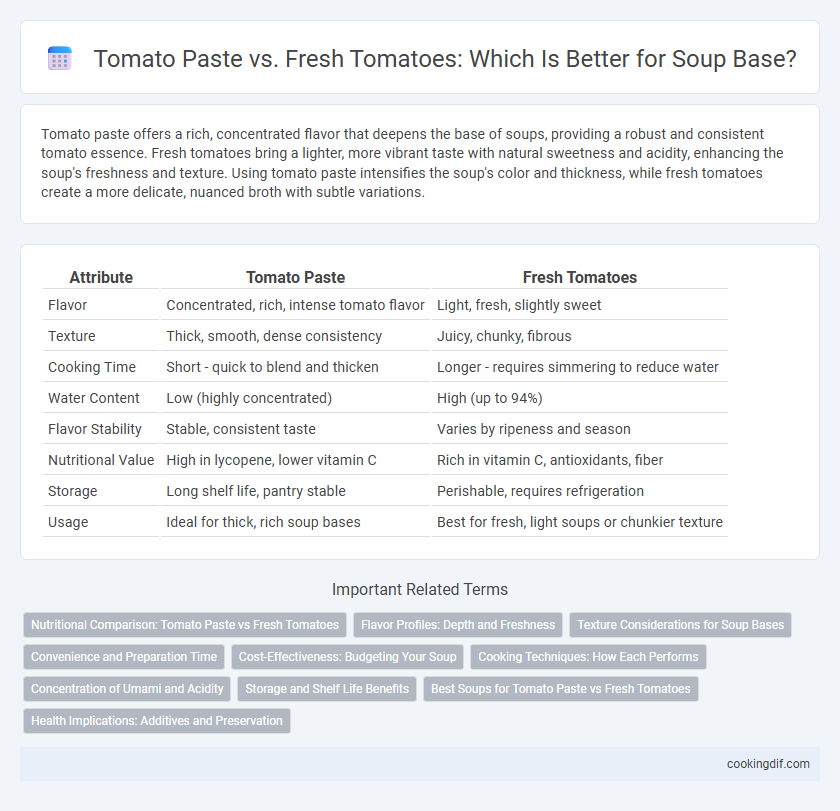Tomato paste offers a rich, concentrated flavor that deepens the base of soups, providing a robust and consistent tomato essence. Fresh tomatoes bring a lighter, more vibrant taste with natural sweetness and acidity, enhancing the soup's freshness and texture. Using tomato paste intensifies the soup's color and thickness, while fresh tomatoes create a more delicate, nuanced broth with subtle variations.
Table of Comparison
| Attribute | Tomato Paste | Fresh Tomatoes |
|---|---|---|
| Flavor | Concentrated, rich, intense tomato flavor | Light, fresh, slightly sweet |
| Texture | Thick, smooth, dense consistency | Juicy, chunky, fibrous |
| Cooking Time | Short - quick to blend and thicken | Longer - requires simmering to reduce water |
| Water Content | Low (highly concentrated) | High (up to 94%) |
| Flavor Stability | Stable, consistent taste | Varies by ripeness and season |
| Nutritional Value | High in lycopene, lower vitamin C | Rich in vitamin C, antioxidants, fiber |
| Storage | Long shelf life, pantry stable | Perishable, requires refrigeration |
| Usage | Ideal for thick, rich soup bases | Best for fresh, light soups or chunkier texture |
Nutritional Comparison: Tomato Paste vs Fresh Tomatoes
Tomato paste contains concentrated nutrients, providing higher levels of lycopene, vitamin C, and antioxidants per serving compared to fresh tomatoes, which have a higher water content and lower overall nutrient density. The paste's concentrated form delivers a richer source of vitamins A and K, essential for immune support and bone health, while fresh tomatoes offer more hydration and a greater amount of vitamin C in a less concentrated form. Choosing between tomato paste and fresh tomatoes depends on the desired nutrient intake and the soup's flavor intensity.
Flavor Profiles: Depth and Freshness
Tomato paste offers a concentrated, rich umami flavor that adds depth and intensity to soups, creating a robust and savory base. Fresh tomatoes provide a bright, vibrant acidity and natural sweetness, enhancing the soup's freshness and lightness. Combining tomato paste with fresh tomatoes balances complexity and brightness, delivering a well-rounded flavor profile.
Texture Considerations for Soup Bases
Tomato paste provides a rich, concentrated texture that thickens soup bases effectively, creating a velvety consistency without adding excess liquid. Fresh tomatoes contribute a lighter, more watery texture, which can result in a thinner soup unless cooked down extensively to reduce moisture. Balancing the intensity and body of the soup often involves combining both ingredients to achieve a well-rounded texture with depth and freshness.
Convenience and Preparation Time
Tomato paste offers unmatched convenience and significantly reduces preparation time compared to fresh tomatoes, as it is already cooked down and concentrated, eliminating the need for peeling, chopping, and simmering. Fresh tomatoes require more extensive prep work including washing, dicing, and longer cooking periods to develop flavor, which can be time-consuming for busy cooks. Using tomato paste streamlines the soup-making process, making it ideal for quick meals while retaining rich tomato flavor.
Cost-Effectiveness: Budgeting Your Soup
Tomato paste offers a more cost-effective base for soup compared to fresh tomatoes, providing concentrated flavor at a fraction of the price per volume. Fresh tomatoes, while offering natural sweetness and texture, can be costly and require more preparation time, often resulting in higher overall expenses. For budget-conscious cooking, tomato paste reduces waste and storage concerns, making it an economical choice without sacrificing essential tomato flavor.
Cooking Techniques: How Each Performs
Tomato paste delivers a concentrated, rich flavor that thickens soups quickly, ideal for long-simmered recipes needing depth and intensity. Fresh tomatoes provide a lighter, more vibrant taste with a juicier texture, requiring longer cooking to break down and develop a mellow sweetness. Cooking techniques involving slow simmering or roasting enhance both bases differently, with paste benefiting from early incorporation and fresh tomatoes performing best when cooked gently to preserve brightness.
Concentration of Umami and Acidity
Tomato paste offers a concentrated umami flavor and higher acidity compared to fresh tomatoes, enhancing the depth and richness of soup bases with fewer ingredients. The cooking process of tomato paste intensifies glutamic acid levels, which amplifies savory notes crucial for a robust soup profile. Fresh tomatoes provide a brighter, fresher acidity but lack the umami concentration needed to create a deeply flavored base without additional seasoning.
Storage and Shelf Life Benefits
Tomato paste offers superior storage convenience and an extended shelf life compared to fresh tomatoes, making it ideal for long-term use in soups. While fresh tomatoes require refrigeration and tend to spoil within a week, tomato paste can be stored unopened for up to a year and refrigerated paste lasts several weeks after opening. This durability reduces food waste and ensures consistent tomato flavor availability regardless of season.
Best Soups for Tomato Paste vs Fresh Tomatoes
Tomato paste provides a concentrated, rich flavor ideal for hearty soups like minestrone and tomato bisque, where depth and intensity are key. Fresh tomatoes offer a brighter, lighter taste perfect for chilled soups such as gazpacho or summer tomato soup, highlighting freshness and natural sweetness. Choosing between tomato paste and fresh tomatoes depends on the desired soup texture, flavor concentration, and cooking time.
Health Implications: Additives and Preservation
Tomato paste often contains added preservatives and sodium, which can impact blood pressure and overall heart health when consumed frequently. Fresh tomatoes provide natural antioxidants like lycopene without the risk of chemical additives, supporting better immune function and reduced inflammation. Choosing fresh tomatoes over tomato paste helps minimize exposure to artificial ingredients and supports a cleaner, nutrient-rich soup base.
Tomato Paste vs Fresh Tomatoes for base Infographic

 cookingdif.com
cookingdif.com